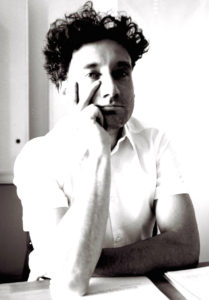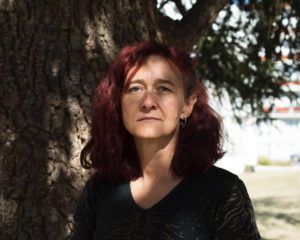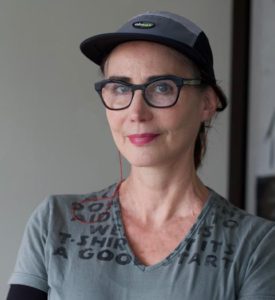Date: Thursday, July 4 at 17.00
Venue: The Latvian National Museum of Art
Ticket – 5 EUR / 3 EUR (student discount) / for the registered
conference participants – free admission (NB! places are limited, please
book your place on the registration desk).
Tickets available at https://www.bilesuparadize.lv/
—
 Jens HAUSER. Greenness: Sketching the Limits of a Normative Fetish
Jens HAUSER. Greenness: Sketching the Limits of a Normative Fetish
Are we ‘green’? The entanglement between symbolic green, ontological greenness and performative greening poses challenges across disciplines that provide an epistemological panorama for playful debunking: ‘green’, symbolically associated with the ‘natural’ and employed to hyper-compensate for what humans have lost, needs to be addressed as the most anthropocentric of all colours. There has been little reflection upon greenness’ migration across different knowledge cultures, meanwhile we are green-washing greenhouse effects away. Indeed, a morbid odour clings to the charm of the pervasive trope of greening everything, from mundane ‘green burials’ to transcendental ‘greening of the gods’, and even ‘green warfare’, taught in Military
Studies. Despite its, at first sight, positive connotations of aliveness and naturalness, the term ‘green’ incrementally serves the uncritical, fetishistic desire to metaphorically hyper-compensate for a systemic necropolitics that has variously taken the form of the increasing technical manipulation of living systems, ecologies, the biosphere, and of very ‘un-green’ mechanisation. Paradoxically, green plays a central role in human evolution and self-understanding – as colour, percept, medium, material biological agency, semantic construct, and ideology. In its inherent
ambiguity, between alleged naturalness and artificiality, employed to reconcile humans with otherness as such, greenness urgently needs to be disentangled from terms—both putatively non-technological—such as ‘life’ and ‘nature’.
Jens Hauser is a Copenhagen and Paris based media studies scholar and art curator focusing on the interactions between art and technology. He holds a dual research position at both the Department of Arts and Cultural Studies and at the Medical Museion at the University of Copenhagen, and leads the (OU)VERT research initiative for Greenness Studies. He is also a distinguished affiliated faculty member of the Department of Art, Art History and Design at Michigan State University, where he co-directs the BRIDGE artist in residency program. Hauser is also the chair of the European Society for Literature, Science and the Arts’ annual 2018 conference in Copenhagen.
fdff
 Luc STEELS. How Nature Inspires Progress in Artificial Intelligence
Luc STEELS. How Nature Inspires Progress in Artificial Intelligence
AI is in the news. However the main technique used to build AI today (statistical machine
learning) captures only a very small part of how Nature manages to create organisms
with amazing adaptive behaviors and how human intelligence with its unique capacities for language, reasoning, and learning, arises and operates. This talk suggests that we have a lot to learn from living Nature. It discusses principles like self-organisation, selection, level formation and emergent functionality and reports experiments how we could use these principles, particularly for explaining the origins and evolution of human-like language.
Luc Steels is a fellow of the Institute for Advanced Studies (ICREA) in Barcelona, embedded in the Institute for Evolutionary Biology (IBE – UPF/CSIC). In the nineteen seventies he studied linguistics at the University of Antwerp (Belgium) and computer science with specialisation in Artificial Intelligence at M.I.T. (US) under the guidance of Marvin Minsky. After working for several years for the company Schlumberger in the U.S. and France on expert systems for geophysical measurement interpretation, he came back to Europe and founded in 1983 the Artificial Intelligence Laboratory of the Free University of Brussels (VUB). With his group he achieved early breakthroughs in symbolic programming, knowledge-based systems, evolutionary computation, neural information processing, and behaviour-based robotics. In 1996 Steels became the founding director of the Sony Computer Science Laboratory in Paris which made major contributions to language emergence, citizen science, and computer music. In 2011 he joined the Catalan Institution for Research and Advanced Studies (ICREA) to work on the use of principles from evolutionary biology to advance the understanding and emulation of intelligence in artificial systems. Steels published a dozen books on various AI subjects as well as 350 research papers published in prestigious conferences and top level scientific journals. He is elected member of the Flemish Royal Academy of Science in Belgium and the European Academy of Science.
 Karine BONNEVAL. Se planter (To plant oneself / To fail) (25 min + 5 min)
Karine BONNEVAL. Se planter (To plant oneself / To fail) (25 min + 5 min)
The first encounter with the Guyanese forest in 2000 was a decisive shock for my artistic research, because this impression of entering into a living whole enabled me to experience sharing of the sensitive with a complex and vibrant ecosystem. As a Western woman and a human being living on earth today, I ask myself a series of questions, which I try to answer partially and temporarily by working with scientists in plant ecology and an ethical philosopher, Karen Houle. Based on a series of images presenting some of the results of these collaborations, the installations, the in situ practical workshops that I share with different audiences, I will unfold the thread of these issues that seems urgent to consider today.
What do we share as human beings with plants?
‘Plant blindness’ – why we fail to see plants?
What can we learn from ourselves by looking at plants?
What can be the value of interdisciplinarity approaches to the study of plant skills?
Plant sentience?
How to regain empathy towards the non-human? The work of Karine Bonneval focuses on the plant otherness, and the complex and specific interactions that link humans and plants.
Born in La Rochelle in 1970, graduated at Angoulème Fine Art school and Strasbourg Decorative Art School, France. Fascinated by vernacular processes, which for ages have allowed humans to express their relationship with the surrounding world, Karine Bonneval develops a vocabulary born from the “hand-made” in order to generate pieces around our contemporary social behaviour. Since 2013, she has worked in collaboration with different teams of scientists in biology to jointly develop projects combining research and sensitive creation around plants and their environments.
________
Public Keynotes and Artist Talks: UN/GREEN
Date: Friday, July 5 at 16.00
Venue: The Latvian National Museum of Art
Agnes MEYER BRANDIS. Walking Trees (25 min + 5 min)
The presentation will focus on my artistic research taking place at various climate and forest research stations in europe over the course of the past couple of years. It will focus on migratory trees and other wandering green species due to climate change. Trees are `rooted`. Though long term observations have shown, that forests actually do move throughout the landscape and regions, just very, very slow and over decades. Climate change appears to happen faster than the trees can escape to more suitable areas in order to survive. Scientists are discussing “assisted migration” in order to help speeding up the process of tree adaption. However, trying to save the trees (and our species on the way) we first need to gain a better understanding what a forest is and does. But the things to observe are either too tiny or too large to simply be looked at, they are as very very slow as well as severely volatile to be easily recognizable. The paper looks at the methods that are invented to do so, along with some new ones invented by the “FFUR Institute for Art an subjective Science” in the fields of climate research, environmental studies, meteorology synthetic and artistic biology, and those who work on it.
Agnes Meyer-Brandis studied mineralogy for a year, then transferred to the Art Academy in Maastricht, the Düsseldorf Art Academy and the Cologne Media Art Academy. She comes from a background of both sculpture and new media art. Her work, exhibited worldwide and awarded, is exploring the zone between fact and fiction – an artistic research on the quest for a degree of reality within constructions. For a more detailed description of her work, please go to her homepage: www.ffur.de
 AnneMarie MAES. Intelligent Beehives (25 min + 5 min) Sensorial Skin for an Intelligent Guerrilla Beehive
AnneMarie MAES. Intelligent Beehives (25 min + 5 min) Sensorial Skin for an Intelligent Guerrilla Beehive
In her talk, AnneMarie Maes will give a quick introduction of the current state of the art of bioart and biodesign in an international context. Following, she will give an overview of the research and development of her long-term biotech project: ‘Sensorial Skin for an Intelligent Guerrilla Beehive’. Her research navigates between experimental urban horticulture, scientific research, and metabolic sculptures. In her experiments she connects living systems and biotechnology with artistic and technological prototyping and experimentation. Her toolset includes microbial life and material science, as well as various measurement and information technologies such as scanning electron microscopes (SEM), sensors, Big Data cloud storage, signal processing, and Artificial Intelligence. Her artworks follow a complex work-methodology combining first-hand observation in research gardens and rooftop apiaries, laboratory probes and digital monitoring combined with a research into new, organic and smart materials. She will highlight past and future collaborations with scientists at universities in Barcelona, Brussels and Amsterdam, with fablabs and Open BioLabs.
AnneMarie Maes is an artist who has been studying the close interactions and co-evolutions within urban ecosystems. Her research practice combines art and science, with a keen interest in DIY technologies and biotechnology. On the rooftop of her studio in Brussels she has created an open-air lab and experimental garden where she studies the processes that nature employs to create form. The Bee Agency as well as the Laboratory for Form and Matter -in which she experiments with bacteria and living textiles – provide a framework that has inspired a wide range of installations, sculptures, photography works, objects and books – all at the intersection of art, science and technology.
Peter ZORN. EMAP – European Media Art Residency programme
EMAP / EMARE is European Media Art Residency Network programme that enables European artists to collaborate on projects and consequently to create closer bonds between European media organisations. EMAP platform is organized by Werkleitz Gesellschaft (Halle); the members include Ars Electronica (Linz), Bandits-Mages (Bourges), FACT (Liverpool), Impakt (Utrecht), Kontejner (Zagreb), LABoral Centro de Arte y Creación Industrial (Gijón), m-cult (Helsinki), Onassis Cultural Centre (OCC) (Athens), RIXC (Riga), WRO Center for Media Art Foundation (Wrocław). The outcomes of EMAP / EMARE production residencies are contemporary media art installations and performances that are shown in various places and festivals throughout Europe. The Un/Green exhibition at RIXC Festival is organized by RIXC Center and it features several artworks that are newly produced during EMAP residencies (2018-2019).
The annual call for submissions is launched in September – http://emare.eu
Waiting for the Light (2018) installation, by Taavi Suisalu (EE) is one of the outcomes of EMAP residency. The artwork introduces baits into the networks and lures in threads of light from different parts of the globe. The Wardian cases function as miniature closed ecosystems and also as islands in this vast network between things. Any object connected to it becomes a target for automated processes – bots – whose motives are mostly unknown. Each plant then becomes an object of interest to these robots whose communicative acts, streams of light, once passed across the floors of oceans, are lit back into our environment as bursts of growth light, giving them an agenda they are unaware of.
Peter Zorn has studied free art in the film class of the Hochschule für Bildende Künste Braunschweig with Prof. Birgit Hein. Co-founder and since then Chairman of the Board of Werkleitz Gesellschaft, on the Board of the Werkleitz Biennale / Werkleitz Festival, since 1995 initiator and manager of the European Media Artists in Residence Exchange (EMARE) Programme of the European Media Art Platform (EMAP) and since 2011 Head of the Werkleitz Professional Media Master Class. He lives and works as a freelance producer, curator and media scientist (e. g. consultant for media art for the Goethe Institute) in Werkleitz and Halle (Saale).